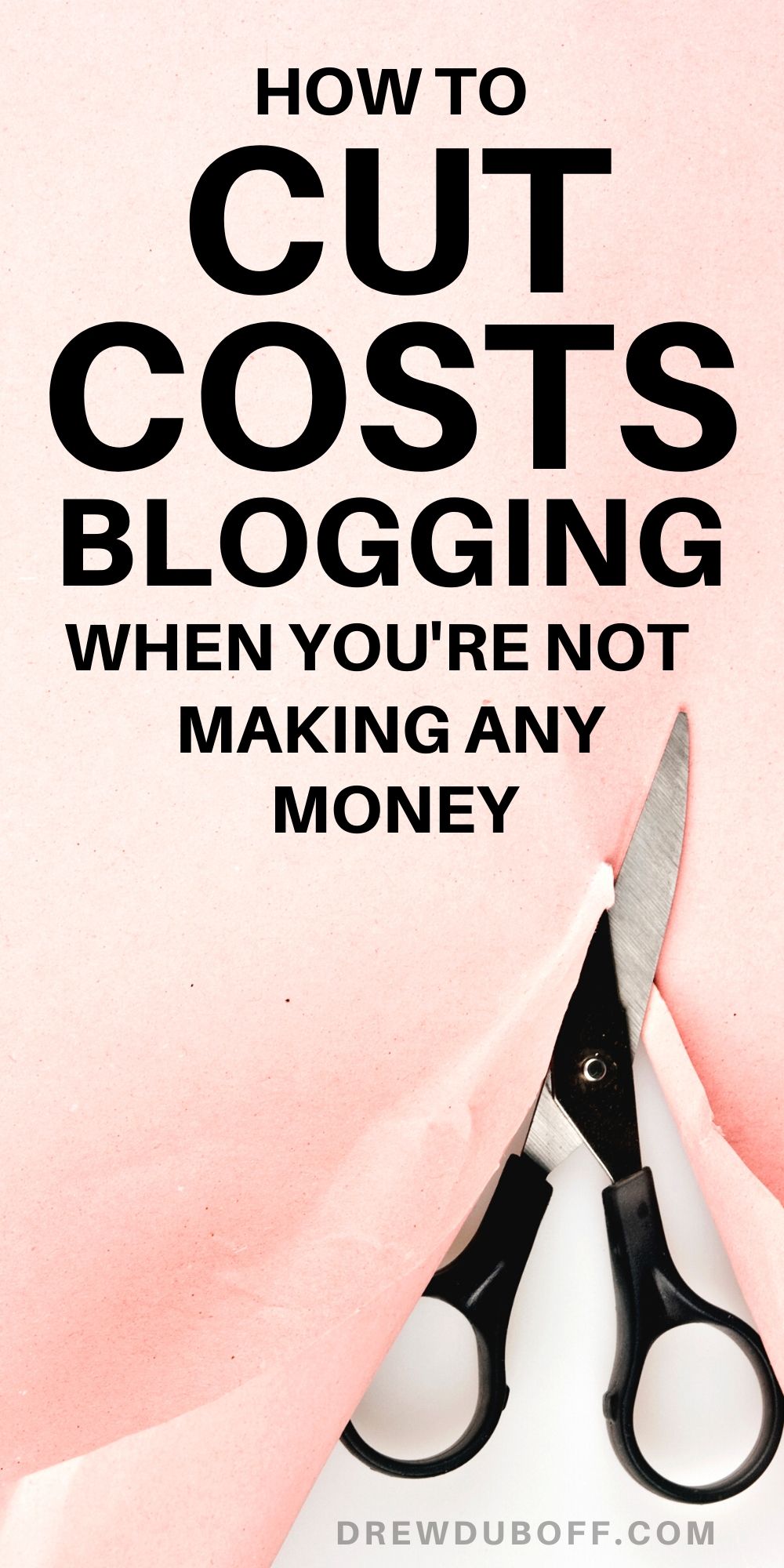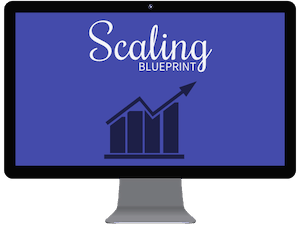Blogging CAN be expensive when you invest in the wrong things upfront.
I should know…
I spent THOUSANDS my first year of blogging (around $5k for a ballpark figure) and I can tell you that A LOT of those costs were unnecessary.
If you want to save money as a blogger and cut costs, then you’ll need to use the free versions of themes, email providers, plugins, landing page software, and more. But, understand that when you decide to NOT spend money, you may delay your blog growth and your chance of success. Your choice!
That being said, I do think blogging on a budget is healthy and you don’t need to break the bank to become a successful blogger.
After all, I spent a lot of money and I still wanted to quit blogging.
If you want to minimize your expenses as a beginner blogger, I have 15 ways for you to accomplish that.
Let’s get started!

15 Ways to Cut Costs as a New Blogger (And Still Be Successful)
Still want to save money as a blogger?
Fair warning, though, that not investing in some things at the beginning may very well jeopardize your chances of success (or delay them significantly).
Nonetheless, here are the ways I came up with:
- Use a free theme (and supplement with a page builder)
- Leverage page builders instead of landing page software
- Set up an account with a free email marketing service provider
- Purchase hosting from a company that offers monthly hosting
- Reverse engineer a respected blogger’s legal pages
- Use public computers at the local library
- Avoid buying software that saves you time
- Stick with free versions of plugins instead of premium plugins
- Learn from one blogger and don’t become a course junkie
- Outsource nothing, including logo design
- Ditch the formal office equipment
- Forward your domain-specific email address to Gmail
- Track accounting with the old fashioned spreadsheet
- Use free blog planners and content calendars
- Leverage organic traffic and don’t pay for ads
Let’s explore these a little more!
1. Use a Free Theme (And Supplement With a Page Builder)
I see many bloggers throwing affiliate links for themes out into the blogosphere.
A lot of those are completely unnecessary and in some cases, cause more harm than good (I’m thinking Divi).
In my opinion, you can do just fine with a free theme and a page builder (also free).
My recommendations for FREE themes:
- Astra
- GeneratePress
You can always upgrade your design to the next level when the money from your blog starts coming in. But, not purchasing a theme can cut costs as a new blogger.
When looking for themes, I try and always find:
- Setup documentation that mimics a mock site
- Ability to submit support tickets
- Community to ask for help (such as a Facebook group)
That’s why I ended up going with my combo of Genesis Framework by StudioPress with the child theme Refined by Restored 316 Designs.
But, you can totally stick with a free theme in the beginning and pay a designer later.
Remember, readers will come to you because of your content, not because of your sexy page design.
2. Leverage Page Builders Instead of Landing Page Software
This piggybacks on my last point of using a free theme, but you can also use free page builders instead of using fancy-schmancy landing page software.
I used to pay over $500 per year for Leadpages!
Not anymore. You can still get good results without paying the big bucks.
My favorite page builders are:
- Gutenberg
- Elementor
- Beaver Builder
If you haven’t tried out Gutenberg yet and are still using the classic editor, try it out! You’d be surprised at what you can accomplish.
There are also plugins that can extend the functionality of Gutenberg blocks, my favorite of which is Atomic Blocks.
I use them on my site!
If you need a good Gutenberg tutorial, my tech guy Grayson Bell knows it well and has a great guide with a video.
3. Set Up an Account With a Free Email Marketing Service Provider
While I use and love ConvertKit, I recognize that not everyone needs to pay a monthly fee to send email newsletters.
In the beginning, I was paying for ConvertKit for many months before I had any subscribers!
You can get started with a free email marketing service provider and upgrade to a paid one later.
The best free ones are:
- MailerLite
- Mailchimp (wouldn’t recommend this as heavily because it’s clunky and hard to use)
- ConvertKit (yep, they just introduced a free plan, but you can’t send emails without referring people or upgrading to a paid plan. But, it’s still good for building landing pages and forms)
As long as you can:
- Create opt-in forms
- Collect subscribers
- Send broadcasts
- Create automations/workflows
You’re set!
Don’t get distracted by all the bells and whistles.
4. Purchase Hosting From a Company That Offers Monthly Hosting
I think this is the biggest offense I see from bloggers who teach others how to start a blog.
They pimp out hosting affiliate links to make a quick buck.
I, for one, am not an affiliate for any hosting companies. I provide you with objective feedback based on my experience and through my fellow bloggers’ experiences.
What I can tell you is that the low prices that are ALWAYS advertised are done so on the longest plan. So, you may get $2.95 per month, but you will have to buy hosting for 3 years to get that and you’ll have to pay upfront for all of that.
That can be a significant investment if you don’t even know you’ll be blogging in 6 months.
For that reason, I think it’s worthwhile to consider getting shared hosting where you can pay monthly.
A couple of trusted providers for that are:
- BigScoots
- DreamHost
Of course, do your due diligence before purchasing hosting.
In case you’re curious, I was one of those bloggers that bought hosting on Bluehost for 3 years upfront to lock in that “special” price. I’m about to expire on that hosting and haven’t needed to change.
But, if you want to get approved by Mediavine, you’ll likely need managed hosting.
For now, you can pay month-to-month, but just note that it may cost a little more per month. If you’re using your salary from your 9-5, then it’s understandable to want to go month to month with your expenses instead of yearly.

5. Reverse Engineer a Respected Blogger’s Legal Pages
Legal pages.
They’re what everyone needs and no one knows how seriously they can help you unless you’ve been in a lawsuit.
When I first started blogging, I found a blogger I respected and reverse-engineered their legal pages.
Now, I admit that I did take a business law course in college AND I had a lawyer review them, so I’m covered.
But, going that route did save me around $150.
I don’t typically recommend MacGyvering stuff when it comes to the law and the IRS, but I think you can make an exception as a new blogger.
After all, businesses that don’t have money won’t get sued!
6. Use Public Computers at a Local Library
I often hear that some bloggers attempt to start a blog when they don’t have a computer or a laptop.
That’s rather challenging to do.
I can barely edit a WordPress post while I’m on my phone. While I was able to perform virtual assistant services for 3 weeks while my computer was broken, I wouldn’t recommend it.
If you can’t afford to buy a laptop, then you can go to the local library to use a computer.
Now, you will have to work around their hours of operation, but it’s certainly an option.
If you use Google Docs to draft your blog posts, you can keep your files on the cloud for easy access.
But, I would highly recommend getting a lightweight, inexpensive laptop to blog with. You really need one to blog successfully.
7. Avoid Buying Software That Saves You Time
Ahh, software.
I bought plenty of software subscriptions in my first year and that’s what drove my expenses so high among other things.
I’m talking about software like:
You don’t need the paid versions of these software programs to succeed.
You can manually pin on Pinterest and resize images the old-fashioned way by recreating designs. It may take you a little longer, but it will save you money as a blogger.
If you’re not sure how much your time is worth, then calculate how much money you make blogging divided by the number of hours. That gives you your hourly rate. Compare that rate to how much time the software can spend and what it costs per billing period.
If you’d rather not go through that process, skip out on the software until you really need it and you feel it’s worth it. And, you can justify the expenses through the money you’ve made blogging.
8. Stick With Free Versions of Plugins Instead of Premium Plugins
You don’t need paid plugins when you start!
Stick with the free versions 🙂
Here are a few examples of what I’m talking about:
- Antispam Bee instead of Akismet for spam protection
- WP Fastest Cache instead of WP Rocket for caching
- Social Pug Free instead of Social Pug Pro for social sharing (now known as Grow by Mediavine)
You don’t need fancy plugins at the beginning.
Minimize your plugin use and stick to the core functions your blog needs to operate.
Don’t go crazy and splurge on plugins because you think you need them. Wait until you can afford them.

9. Learn From One Blogger and Don’t Become a Course Junkie
I’m still guilty of disobeying this strategy.
I am a self-professed course junkie!
I’ve paid money for courses and haven’t even opened them. Yep, what a waste of money until I start using them.
Don’t do that. Purchase one eCourse or eBook from a blogger you trust that has gone down a similar path and worship their content. Absorb everything and join blogging Facebook groups.
You’ll get plenty of knowledge that way instead of buying information products on everything.
I know plenty of successful bloggers that didn’t buy courses for their first 6 months.
Trust me, you’ll save a lot of money as a blogger this way. I’m talking HUNDREDS, if not THOUSANDS.
10. Outsource Nothing, Including Logo Design
It can be tempting to check out Fiverr or Upwork and outsource something there for dirt cheap.
I wouldn’t recommend it and I teach people how to outsource!
Here’s the thing…
You’ll end up with lackluster service providers and likely have something worse to show for it.
This includes logo design. You don’t need to outsource this.
Just design something in Canva that’s text-based and you’ll be set. That’s how I did mine.
11. Ditch the Formal Office Equipment
It’s true.
You don’t need an elaborate office set-up to succeed at blogging.
I blog at the dining room and occasionally in front of the television.
You don’t need an office.
You especially don’t need a microphone and a webcam in the beginning until you start doing podcasts, video interviews, and live streams. I got mine many months into blogging and when I did, they cost about $100 together.
But, they are tax-deductible.
If you think you need dedicated office space, then consider going to the local library and mooching off their WiFi to get work done. It’s an environment where people won’t distract you.
12. Forward Your Domain-Specific Email Address to Gmail
I believe in the beginning that it’s not necessary to use something such as GSuite to provide you with a domain-specific email address.
All you need is to set up a domain-specific email courtesy of your web host and then you’ll want to do the following:
- Open up a blog Gmail account (something like yourblog@gmail.com)
- Import your domain-specific email account into the Gmail account
- Add your domain-specific email address as a sending email address
- Make your domain-specific email address the primary/default sender
And, you’re good to go!
That should save you about $6 per month, but I do think GSuite is worth it as you begin to make more money blogging.
After all, there is some rhyme and reason to keeping your domain-specific email off your hosting provider’s servers in case you get hacked. But, in the beginning, you’ll be just fine.

13. Track Accounting With an Old-Fashioned Spreadsheet
You don’t need fancy accounting software in the beginning!
I swear…
I used to use Microsoft Excel and had a spreadsheet that tracked my revenue and expenses. It worked in the beginning and it was all I needed to separate my business spending from my personal spending.
Eventually, I opened an account with Wave to make the process a little more streamlined.
They’re still free, by the way, but in all disclosure, I stopped using them because the transactions weren’t syncing well.
Now, I use and love QuickBooks, but you don’t need that in the beginning. Stick with free solutions as your expenses and revenue are minimal.
14. Use Free Blog Planners and Content Calendars
Truth be told, I don’t really use a blog planner or a content calendar.
But, I know many people who do!
I’m just not one of them. I still wouldn’t spend money on one at the beginning.
You can use something simple such as:
- Spreadsheets
- Clickup (project management software)
Both of my suggestions are free to use.
If you need a daily planner, then I recommend the daily planner by Sarah Titus. It’s over 470 pages and it’s completely FREE!
15. Leverage Organic Traffic and Don’t Pay for Ads
I’m a big fan of not paying for traffic unless you need to.
At the time of writing this article, I still have not paid a dime on paid advertising and I do this online business thing full-time.
If you want Google traffic, check out this interview with Mike Pearson. If you want organic Pinterest traffic, check out this interview with Carly Campbell.
You simply don’t need to pay for traffic because you’ll get depressed if you stop ads and you don’t have traffic anymore. I’ve seen it happen!
And, please don’t “boost” your Facebook posts. Terrible ROI.
Yes, organic traffic may take much longer to get, but it is CONSISTENT and it will make you more money.
Now, I’m not saying that targeted ads won’t help you grow your business. You just have to do it sensibly and only after you have a converting blog post or email funnel.
Conclusion
Have you determined how you want to save money as a blogger?
Or, have you realized that some things are just worth paying for?
For me, personally, I’ve found that paying a few hundred dollars yearly to save me hours is completely justified, but I know that in the beginning, you might be blogging on a budget and I respect that.
Some of my blogging buddies didn’t spend much outside of domain and hosting when they started. An example would be Kelan Kline.
You could be the next to do that!
To quickly recap, we discussed these ways to save money as a blogger:
- Use a free theme (and supplement with a page builder)
- Leverage page builders instead of landing page software
- Set up an account with a free email marketing service provider
- Purchase hosting from a company that offers monthly hosting
- Reverse engineer a respected blogger’s legal pages
- Use public computers at the local library
- Avoid buying software that saves you time
- Stick with free versions of plugins instead of premium plugins
- Learn from one blogger and don’t become a course junkie
- Outsource nothing, including logo design
- Ditch the formal office equipment
- Forward your host-specific email to Gmail
- Track accounting with the old-fashioned spreadsheet
- Use free blog planners and content calendars
- Sign up for a free project management software
What’s your favorite way? Did we forget something? Let me know in the comments below 🙂
Cheers to your blogging success!








Great, great article! I learned most of those things on the list are things I actually did. I got pretty good advice as a newby blogger on how to save $$ as I’m un-employed and running low on savings. Trying to get the blog going on a shoestring…but it’s not doing too bad all things considered. It’s a huge learning curve and it’s time-consuming to manual pin on Pinterest all the time and to keep it consistent…but you are RIGHT it CAN be done! I’m at home all day—what do I have to lose? But all the things on your… Read more »
Thank you so much, Kris! That’s great that you’re already following best practices. I remember freelancing in the beginning just to have the necessary dollars to fund my business expenses. The good thing with Pinterest is that you can use the native Pinterest scheduler to at least schedule some content. Manually pinning should get a marginally better result, but if you’re in a pinch, it’s a solution that works well. Yes, it CAN be done! Whoever recommended all those things to you was definitely right 😉 Committing for the long haul is great! You’ll get there — just don’t be… Read more »
Great post full of invaluable info! So many new bloggers get sucked up into spending unnecessary money at the beginning. Blogging is one of the most inexpensive businesses to start, even on a shoestring budget. I love love love #9! I picked a blogger I meshed with at the very beginning and followed everything she said cutting out the other noise. Thank you for providing such an honest post.
Jada, SO glad to hear from you and I’m happy you enjoyed the post. Yes, many bloggers unnecessarily spend money, so the intention was to prevent that. Of course, I’m all for investing when you need to, but some things are not needed. And, yes, blogging is a cheap business compared to others! Glad you liked #9! I followed it myself to a certain extent after which I bridged out to other creators. I’m glad the honesty is well-received. Please feel free to spread the love and share on social media 🙂